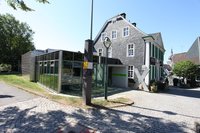Professor Pietro Blaserna aus Rom bedankt sich bei Wilhelm Conrad Röntgen für die sehr interessante Mitteilung auf seiner Visitenkarte.
Blaserna war Professor für experimentelle Physik an der Universität Rom und der Gründer des dortigen Institutes für Physik. Er war wohl einer der Empfänger der ersten Veröffentlichung Röntgens zu den X-Strahlen.
en













